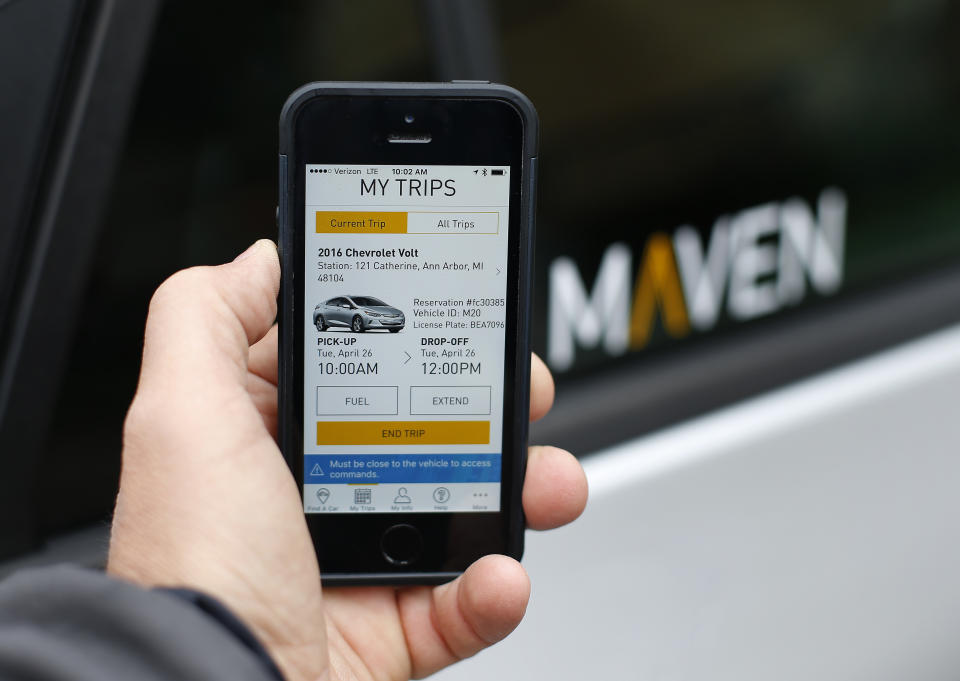How GM is fighting back against Silicon Valley
Disrupted? Not yet.
General Motors (GM) is one of those old dinosaur companies that’s supposed to disappear any day now, just one more casualty of smarter, faster startups fueled by venture capital. You know, Tesla (TSLA) will build better cars, Google (GOOGL) will develop the robots that drive them and Apple (AAPL) will revolutionize the whole business with something nobody else can even imagine.
Except that General Motors has a couple of interesting ideas of its own, along with the know-how to build a full range of automobiles. GM even turns a profit building cars, which might not be cool but does help fund experiments that might lead to something big one day.
While Uber has been self-immolating and Tesla has been hemorrhaging cash, GM has quietly rolled out a program during the last 18 months called Maven that could eventually snatch a big piece of the market for people who need a ride every now and then but don’t want the hassle of owning a car.
“We see a big shift coming for consumers who don’t want to own cars, especially in metro areas like New York,” Julia Steyn, who’s in charge of Maven, tells Yahoo Finance in the video above. “Some consumers want access to the transportation versus buying a car that sits in the garage 95% of the time.”
Maven operates in 17 cities and has about 100,000 members so far. The program works like this: You download the app to your phone and provide your driver’s license number, along with some other personal info. Maven verifies your ID and checks your driving record to make sure you’re not a serial car-wrecker. If you qualify, you’re then eligible to rent a GM vehicle for as long as you like, be it an hour or a week, whenever you want.

You choose your ride on the app when you make a reservation, from small fleets stashed around the city. Available models include the all-electric Chevy Bolt, the Chevy Malibu, the Buick Regal, the Cadillac Escalade and in some places, the Chevy Corvette. There’s no fee to belong to Maven; you only pay rental fees, which include insurance and, for the electric Bolt, complimentary high-speed charging. You get billed automatically, through a payment method established when you sign up.
The Maven model, unlike Uber or Zipcar, allows GM to vertically integrate its hardware with an in-house service. Since GM owns the vehicles, it can put whatever cars it wants in the Maven fleet, optimizing costs and efficiency. One part of the program, called Maven Gig, is for people who want to rent a GM car to help them make money, as an Uber driver, say, or a GrubHub deliverer. Those cars tend to be lightly used models coming off-lease after two or three years. Reacquiring those cars from dealers and using them in the Maven fleet might be more efficient for GM than releasing them into the used market, which can depress prices if there’s an overabundance of any given model.
GM can also tweak the Maven vehicles to make the program more seamless and appealing. GM has modified all cars in the Maven fleet, for instance, so that the member unlocks and operates them using only a Bluetooth-enabled smartphone; there are no keys. When you arrive at the vehicle, you push an unlock button on the app and, lo and behold, it unlocks. Then you get in, press the start button and go. That eliminates the need for an attendant of some kind to provide the keys. GM engineered and installed that feature itself, something Uber, Lyft, Zipcar can’t really do because they don’t manufacture the cars used as part of their service.

The Maven logo on a General Motors car-sharing service automobile. (AP Photo/Paul Sancya)
GM doesn’t say if Maven is profitable on its own. The company does say that 79% of the program’s customers are 30 or younger, which would be a boon for an automaker whose traditional customer base grew up using rotary phones. GM also tends to fare poorly in urban areas, where imports and more popular than domestics, so any new traction in cities would be welcome.
“Maven is a platform for GM to capture customers we didn’t have before,” Steyn says.
GM is hardly the only carmaker exploring new ways of getting people to use cars. Ford (F) has a new “mobility ” unit testing shuttles, bike networks and other ways of getting around, though the company’s board did boot former CEO Mark Fields earlier this year for not driving the company into the future fast enough. Toyota (TM), Volkswagen and BMW have partnered with ride-sharing startups such as Uber and Scoop. And all the automakers are working on self-driving systems, which could transform the car business more than any app once the technology matures in 10 or 15 years. On top of that, all of these companies know how to build cars.
Confidential tip line: rickjnewman@yahoo.com.
Read more:
Rick Newman is the author of four books, including Rebounders: How Winners Pivot from Setback to Success. Follow him on Twitter: @rickjnewman.


